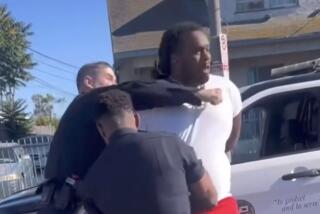When the LAPD is tested, it’s by multiple choice
- Share via
The cry of police brutality in the beating case of car-theft suspect Stanley Miller is likely to continue until the LAPD determines that the cop who pounded him with a flashlight while Miller was on the ground was operating within departmental guidelines.
I will not be as excited or as angry as you when Officer John Hatfield, the alleged pounder, walks away whistling and smiling without a blemish on his record, and is issued a new flashlight to replace the one with dents in it.
Those of you who lack my investigative skills are probably unaware of the test given to the men and women aspiring to become members of the wonderful organization that gave us the Rodney King beating and the 1992 riots, among other notable milestones.
It’s a test that more often than not confuses the recruits entering the Police Academy, and continues to confuse them as they face critical situations on the street, such as whether working over a car-theft suspect when he is on the ground surrounded by eight burly cops is considered an unethical use of force or simply a recreational beating.
Allow me to illustrate. I happen to have a copy of some of the test questions at hand. Here’s one example:
“When you have a car-theft suspect lying face-down on the ground surrounded by a small army of your fellow officers, do you: (1) Apologize. (2) Read him his rights. (3) Steal his wallet. (4) Beat him with whatever is handy. (5) Call him nasty names?”
The correct answer, of course, is 5, but when an officer on duty is confronted with such a situation, he often panics and jumps instantly to 4, which is what occurred in the Stanley Miller case. Sometimes, in utter confusion, he might even 1, 2, 3 and 5 him before going to 4. In one famous case, the officer actually 1’d the suspect and then allowed him to go free. The cop was, of course, dismissed.
A subsection to that question asks: “If your answer is 4, what is the best instrument to employ in the beating of the prone, whimpering suspect: (1) Your shoe. (2) A rifle butt. (3) Your grandmother’s umbrella. (4) Your flashlight. (5) Your hankie?” If you guessed 1, you have answered correctly.
Another test question: “If you feel the suspect has something in his pocket that might be a handgun, an M-16 rifle or an 80-mm mortar, you should: (1) Shout ‘Gun!’ (2) Holler ‘Doughnuts!’ (3) Search him in a prescribed, legal manner. (4) Run to your mommy. (5) Instantly telephone a newspaper columnist for advice.” Forty-two percent of those who took the test answered, incorrectly, 4. The correct answer is 5.
Finally: “Which of the following is considered to be a dangerous weapon: (1) A shoulder-mounted ground-to-air missile. (2) Tweezers. (3) A screwdriver. (4) A sheathed saber. (5) A 15-foot Nile crocodile.” The correct answer is, of course, 5. In the event a suspect is carrying a Nile crocodile over the legal 8-foot limit, every precaution should be taken while citing, and then beating, the suspect and his crocodile.
Another element of the test that each recruit must take is the question of whether altering the truth is the proper response to a situation that might threaten his or her career. In the case of the flashlight beating of Stanley Miller, the assertion that he was carrying a pair of wire cutters in his pocket has been challenged by an officer who claims that the wire cutters were found not in Miller’s pocket, but in the car he allegedly stole, which was 200 yards away.
Those who claimed the wire cutters were in his pocket and who mistakenly thought they were a gun were not misspeaking, or, as a layman might put it, lying through their teeth.
Departmental policy clearly states that any potentially dangerous weapon, such as wire cutters, paper clips or loaded lipstick tubes, are considered to be on the suspect’s person if they are found within 300 yards of the location where he or she is being restrained and legally beaten.
I’m certain that once everyone understands the potential for confusion that can result from the test that all recruits must take, and once departmental policy regarding the definition of a potential weapon’s location is clarified, we can all go back to a normal life of worrying about smoking on the beaches and the illegal use of silly string (also listed as a dangerous weapon in the police manual) in public places.
The LAPD will be out there, serving and protecting.
Al Martinez’s column appears Mondays and Friday’s. He’s at al.martinez@latimes.com.


